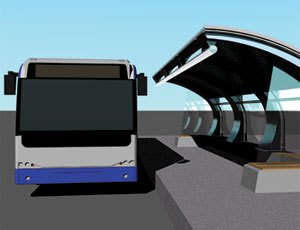Building information modeling, still relatively rare in the transportation construction world, proved key in gaining public approval for a planned $573-million, 9.4-mile rapid-transit bus system in Hartford, Conn. Advocates hope transit agencies will begin to ramp up use of BIM in future projects.
The Connecticut Dept. of Transportation had planned on design-build for the line connecting Hartford and New Britain. “We had a designer bring the project from [environmental permitting] to 30% design,” says Michael Sanders, ConnDOT transit administrator. But after then-Gov. John Rowland (R)—who had approved special design-build legislation—was sentenced to jail in 2005 for fraud, the agency scrapped that plan, he says.
Switching to design-bid-build, ConnDOT selected SEA Consultants Inc., Cambridge, Mass., to design the 11 stations. SEA was recently acquired by Kleinfelder Inc., San Diego. “Our first task was to look at all the sites and reconceive them,” says Albert G. Bisacky, SEA principal engineer. “There are four communities, and it was a challenge to incorporate all their ideas.”
Sanders says the rapid-transit bus line will be one of the nation’s few with a separated fixed guideways. “We always wanted to have a cutting-edge feel to it,” he says. But ConnDOT had to keep budget constraints in mind. “We looked at unique structures at first, then thought about the costs,” says Bisacky. “That led us to standardize the station components.”
The planned stations all follow a basic design theme of at-grade stations with parabolic-arched canopies that will be prefabricated. Stainless steel and glass will provide the desired futuristic look. Designers asked residents at public meetings to list their top priorities regarding station elements, says Karen E. Arpino, SEA’s transportation director.
The resulting 3D images helped the community visualize the stations from all angles. “It wasn’t that it never had done it before, but that the public mostly hasn’t seen that before,” says Sanders. “If you’re going out to the public, a picture is worth a thousand words. This was worth five thousand words.”
Final design will be completed this year, with construction slated for 2011, says Sanders. ConnDOT anticipates a $264-million Full Funding Grant Agreement from the Federal Transit Adminstration. The first bids on early items are scheduled for this fall. “There will be segments with busway bridges, some with just pavement,” he says. “Others will involve working alongside Amtrak.” Arpino says SEA is now talking to Massachussetts transit officials about using BIM. “Contractors are sophisticated in BIM,” she notes. “We’re ready to show owners the tool and what it can do for them.”





Post a comment to this article
Report Abusive Comment